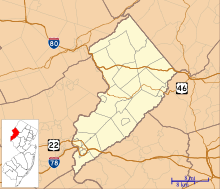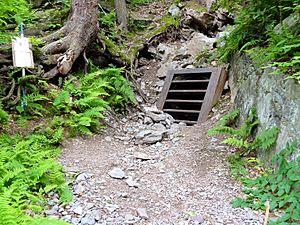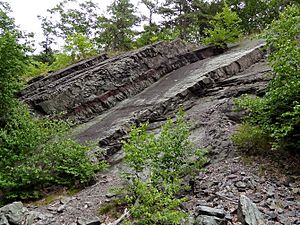Pahaquarry Copper Mine facts for kids

Adit Number 1
|
|||||||||||
| Location | |||||||||||
|---|---|---|---|---|---|---|---|---|---|---|---|
| Location | Delaware Water Gap National Recreation Area | ||||||||||
| State | New Jersey | ||||||||||
| Country | United States | ||||||||||
| Coordinates | 41°02′17″N 75°01′39″W / 41.03806°N 75.02750°W | ||||||||||
| Production | |||||||||||
| Products | Copper ore | ||||||||||
| History | |||||||||||
| Opened | 1750s | ||||||||||
| Active | 1750s, 1847–8, 1861–2, 1901–11 | ||||||||||
| Closed | 1928 | ||||||||||
| Owner | |||||||||||
| Company | National Park Service (current) | ||||||||||
| Website | http://www.nps.gov/dewa | ||||||||||
|
|||||||||||
The Pahaquarry Copper Mine is an old copper mine that's not used anymore. It's located on the west side of Kittatinny Mountain in Hardwick Township, Warren County, New Jersey, in the United States.
People tried to mine copper here for short times in the 1700s, 1800s, and early 1900s. But it never made much money. This was because the rock they dug up didn't have enough copper in it.
Today, you can find old mine buildings, hiking paths, and waterfalls at the site. It's part of the Delaware Water Gap National Recreation Area and is managed by the National Park Service. In 1980, it was added to the National Register of Historic Places as part of the Old Mine Road Historic District.
People used to tell stories that Dutch miners started digging for copper here before 1650. They even said the miners built a 104-mile (167 km) road, the Old Mine Road. This road supposedly connected the mines near the Delaware Water Gap to Kingston, New York. However, newer research shows this isn't true. The road was likely built by Dutch families settling the area in the 1700s.
We know for sure mining started around 1740. John Reading, Jr. funded a short mining attempt then. Later efforts in the mid-1800s and early 1900s were also short and didn't work out.
Contents
History of the Pahaquarry Mine
Old Stories About Dutch Miners
There are several old stories about this mine that historians and scientists have shown aren't true. One story claimed that the Lenape Native American people mined here even before European settlers arrived. But tests show that copper items found here came from big copper mines far away in Isle Royale and the Keweenaw Peninsula in Michigan.
Another story said that early Dutch settlers from New Netherland found and worked the mine in the 1650s. This led to the legend that the Dutch built the Old Mine Road. This road was said to stretch 104 miles (167 km) to Esopus, New York, to carry the copper ore. A nearby sign tells these stories, but there's no real proof. Many books and websites still repeat these old stories as if they are facts.
Mining Attempts: 1750 to 1910
The Pahaquarry mine was active for three short periods. The first records are from the 1750s. John Reading, Jr. and his partners bought land near Mine Brook in Walpack Township. Reading was a well-known surveyor and land investor. He also served as the acting governor of the Province of New Jersey for a short time. By 1760, this mining attempt had failed, and work stopped.
The next try began in 1847. A group of men from Flemington, New Jersey, formed the Alleghany Mining Company. New mining work started but quickly ended in 1848. This was because the copper ore was not good enough.
New leaders of the company restarted mining in 1861. But again, the work stopped quickly the next year.
In 1867, a man named Aaron Keyser bought the land. He wanted the bark and timber from the trees. This ended when the land was given back to the Alleghany Mining Company in the 1890s.
The last attempt to mine copper began in 1901. The Montgomery Gold Leaf Mining Company bought the Alleghany Mining Company's property. This company was started by brothers Henry and Oliver Deshler.
After not having much success, the company changed its name in 1904. It became the Pahaquarry Copper Company. Over the next few years, they built a large mill to process the ore. They also built other buildings and equipment. The mill changed a lot because the new technology was still being tested.
New ore was not dug until 1911. Mining stopped after only three months. They might have only made three small blocks of refined copper. The last of the mining equipment was taken away in 1928. This was the end of copper mining in the area.
From 1925 to 1972, the area was used as a camp for the Boy Scouts of America. Later, the United States Army Corps of Engineers bought the land. They planned to build the Tocks Island Dam, a project that caused a lot of debate.
Geology of the Mine Site
The copper ore found here is a grayish mineral called chalcocite. This copper sulfide is found in a hard gray sandstone rock. This rock is part of the Bloomsburg Formation. It's hard to see the copper because it's the same color as the rock. Also, there isn't much of it.
Other minerals you might see here are green malachite and blue-green chrysocolla.
Between 1903 and 1906, a scientist named Dr. Keith studied the ore. He reported that 100 samples had about 3.25% copper. But in 1943, the United States Geological Survey did more tests. They found much less copper, only 0.11% to 0.38%. Because of this, they said that no more mining should be done at Pahaquarry.




